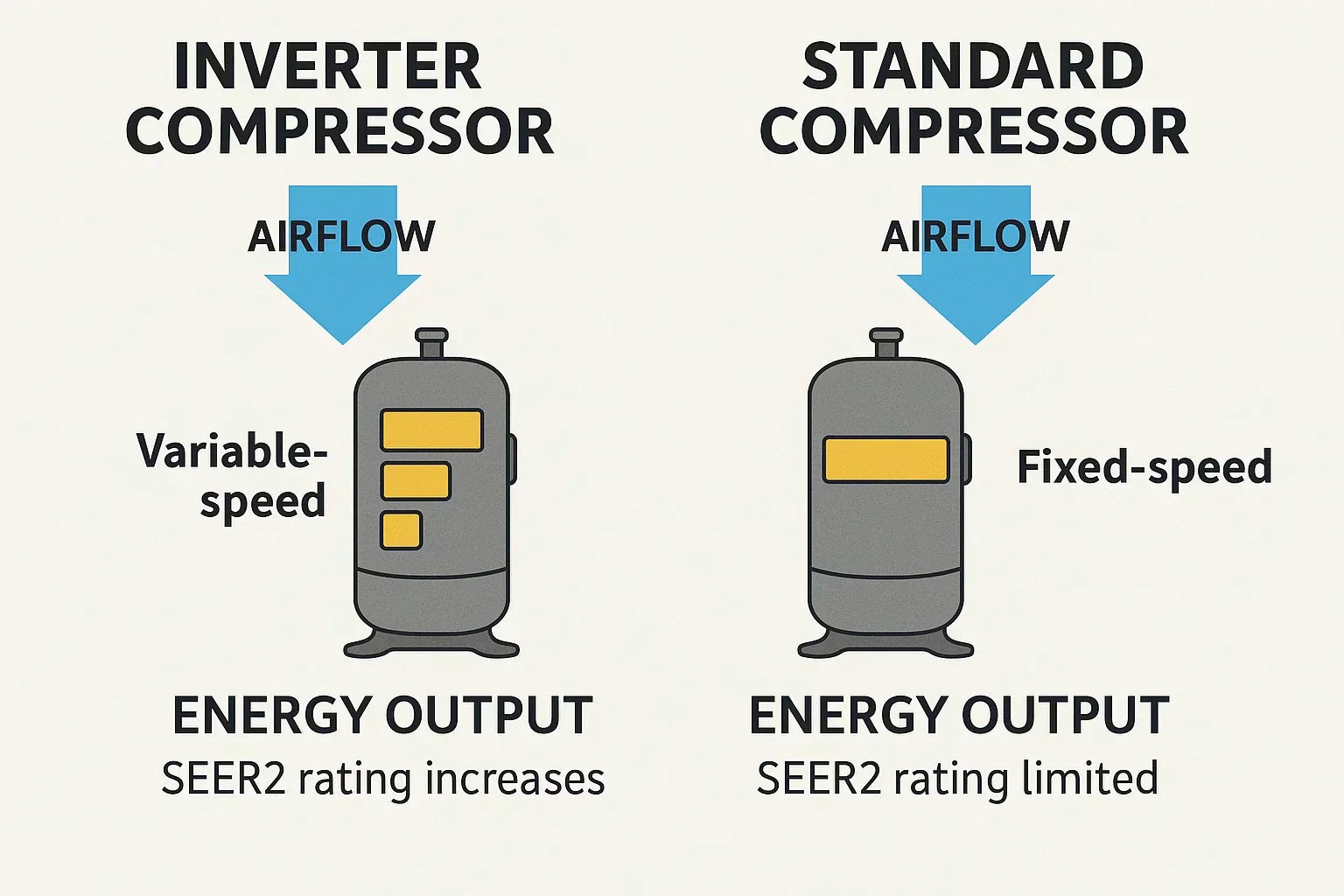When you hear the term “high-efficiency HVAC”, chances are SEER2 ratings and inverter compressors are behind the performance. SEER2 measures how efficiently a cooling system runs under real-world conditions. Inverter compressors are the technology that makes hitting those high efficiency numbers possible.
Together, they’re changing the way modern HVAC systems deliver comfort, savings, and reliability.
In this post, I’ll break down how inverter compressors work, why they pair so well with SEER2 systems, and what that means for your home—and your wallet.
📘 Want to understand the foundation first?
👉 What is SEER2 and Why It Matters
What Is an Inverter Compressor?
Traditional air conditioners use one or two speeds. When it’s hot, the system turns on full blast. Once the temperature is reached, it shuts off. That’s called short cycling—and it’s hard on the system, inefficient, and noisy.
An inverter compressor doesn’t just flip on and off—it adjusts. It runs at variable speeds depending on how much cooling is needed. Think of it like cruise control for your HVAC.
This allows the system to maintain a more stable indoor temperature with less effort, especially during partial load conditions (like mornings or evenings).
📘 Daikin – Inverter Technology Explained
📘 Goodman – What Is an Inverter HVAC System?
How Inverter Compressors Boost SEER2 Ratings
SEER2 testing reflects how systems perform under realistic conditions, including resistance in ductwork (external static pressure). Systems that excel under these conditions are typically inverter-driven.
Here’s how inverter compressors directly contribute to higher SEER2 ratings:
-
Part-load efficiency: Inverters shine during mild days when full power isn’t needed. That’s exactly how SEER2 is measured.
-
Reduced energy spikes: No hard starts or stops—just smooth modulation.
-
Smarter fan speeds and airflow matching.
-
Fewer temperature swings = better dehumidification and comfort.
All these benefits allow manufacturers to build systems that meet or exceed SEER2 minimums (14.3 SEER2 in most regions)—and reach elite ratings like 18 or 20 SEER2.
Why Homeowners Should Care
Inverter + SEER2 isn’t just tech jargon—it directly impacts how your home feels and how much you pay to keep it comfortable.
Benefits for homeowners include:
-
Lower energy bills: Less waste, better modulation.
-
Quieter operation: Inverter systems often hum instead of roar.
-
Longer lifespan: Reduced wear and tear from constant cycling.
-
Improved air quality: Constant operation = better filtration and dehumidification.
-
Smart thermostat integration: They play nicely with zoning systems and automation tools.
📘 Mitsubishi Electric – Inverter Heat Pump Technology Explained
Are Inverter Systems Worth the Higher Upfront Cost?
Short answer: In most cases, yes.
While inverter systems do cost more initially, their operating savings and comfort upgrades often justify the investment—especially in climates with long cooling seasons.
Let’s break it down:
| Feature | Standard AC | Inverter SEER2 System |
|---|---|---|
| Efficiency | 13–14 SEER | 14.3–20+ SEER2 |
| Lifespan | 10–15 years | 15–20+ years |
| Energy Use | Higher | 20–40% lower |
| Comfort Control | Basic | Precise & Adaptive |
| Noise Level | Louder | Quieter (variable) |
📘 Energy.gov – Heat Pump Systems Overview
When to Choose Inverter + SEER2 Systems
You should seriously consider upgrading to an inverter-driven system if:
-
You live in a hot or humid region and run your AC frequently.
-
Your current unit is older than 12 years and nearing replacement.
-
You want zoned cooling or have an open-concept layout.
-
You're planning to stay in your home for at least 5–7 years.
-
You value quiet operation and consistent comfort.
If you're house hunting, ask the seller or builder whether the system includes an inverter compressor. Many high-SEER2 models do—but not all.
Final Thoughts from Alex Lane
Inverter compressors are the unsung heroes behind the newest generation of high-efficiency HVAC systems. Paired with SEER2 testing standards, they help homeowners unlock a perfect balance of comfort, control, and energy savings.
So if you’re evaluating HVAC options, don’t stop at SEER2. Ask:
“Is it inverter-driven?”
That one question could save you thousands over the life of your system.
👉 Curious how SEER2 ties into your home’s energy rating or resale value?
Check out the next article in the series:
How SEER2 Ratings Affect Home Energy Scores and HERS Index
Alex Lane
Your Home Comfort Advocate







